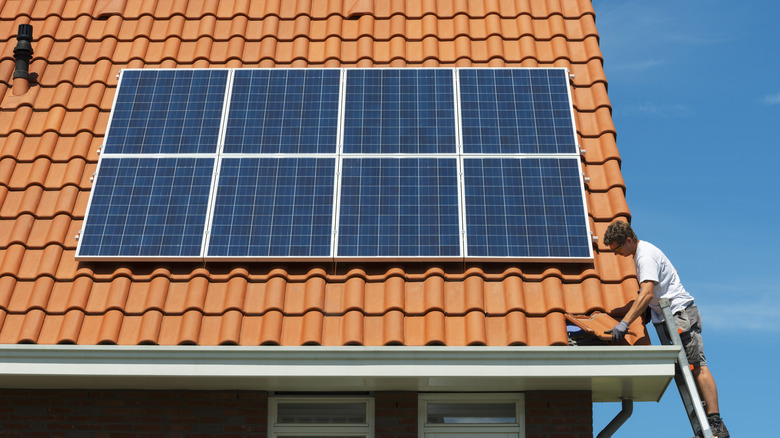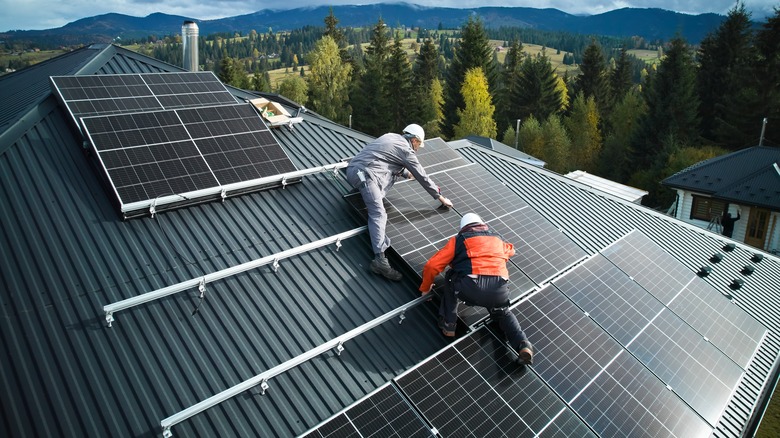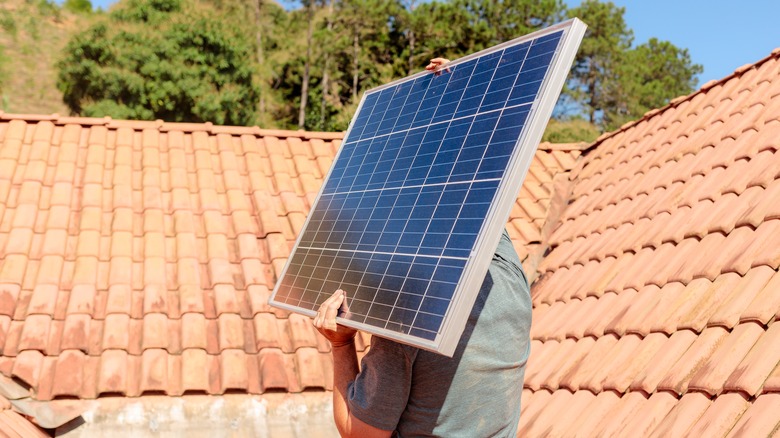Are DIY Solar Kits Worth It Or A Waste Of Your Energy?
With home energy bills outstripping both inflation and wage growth, it's not surprising that some people are gazing into the sky and thinking of all that free solar energy. But there are a lot of reasons to go solar, and they don't all involve the expense of power. Installing a renewable energy system in your home to save on your electricity bill is a little like buying a farm because your grocery bills are too high: A great idea, if you can afford the farm and can invest the time to keep it profitable. DIY solar kits are a bit of a different situation, though. They're more akin to a small hobby farm that is a lot of work and produces some eggs and veggies, but doesn't dramatically lower your food spending. What you get out of the experience might justify the effort and expense — it just depends on exactly what you want to accomplish.
In general, DIY solar panels are best used to power single devices or small systems like a cabin, tiny home, or RV. According to the National Renewable Energy Laboratory (NREL), they can only supply around 10% of the power needs of an average home. DIY kits include two to four panels, while a home would require 20 to 24 full-sized panels to fully replace grid electric power. The packages also include inverters, some wiring, mounting hardware, and might include documents to help with processes like securing permits. Some also include charge controllers, but few include batteries for energy storage.
How difficult is it to install?
One key way DIY kits differ from full-house solar installations is, of course, that they're comparatively easy to install. But that doesn't mean you won't hit any snags. It really isn't the equipment that poses daunting challenges but the way they have to be integrated with our homes. For the most part, that means mounting photovoltaic (PV) panels to your roof (unless you go with a ground-mounted system) and sometimes connecting the output to your breaker box.
Installing a rail-mounting setup on your roof isn't especially difficult, but it's not for the faint of heart in a few important ways. First of all, you'll be on your roof, and not everyone's great at that. Then you're going to do some measuring (from inside and outside the house) and mark the rafter locations. However nerve-wracking those processes were, the next step can be down right harrowing: You're about to intentionally penetrate your roof in a number of places. You need to be comfortable with that and, more importantly, be competent at it or you're going to have bigger problems than your power bill.
Connecting your solar system to your home's electrical network is a whole other ball of wax and is best left to a licensed electrician. In fact, it's probably required in most jurisdictions, and you'll certainly need the sign-off of an inspector or licensed electrician for any grid-tied/net metering situation. After all, solar interconnects and backfeed breakers require messing about in your breaker box, which can result in fires, electrocution, or both.
Is it worthwhile to install a DIY solar system?
Let's look at the money involved in a renewable system. After savings from solar panel tax credits, EnergySage says the average full-house solar setup costs around $21,000, and potentially more for a solar leasing arrangement. DIY kits, on the other hand, vary wildly in both cost and what they can do for you. They might power a fourth of your house — or only be able to run a single appliance. But it's a learning experience and a step toward energy independence.
What's next after that? It's usually possible to expand small DIY solar setups later, but because it typically involves upgrading some components, it's not necessarily cost-effective. That doesn't make it a bad idea — it's a good way to dip your toes into the solar stream without committing to the full $20,000. You will certainly save money by doing the installation yourself, as long as it's done properly. And it could be a good investment even before you recoup the cost of the apparatus since adding solar panels tends to increase home value.
Of course, all of this assumes that a DIY installation is allowed by your local zoning regulations and won't void your system's already sketchy warranty. And those tax incentives? Make sure they don't require a professional installation as well. You'll also have some paperwork to manage, like permits and tax documentation that is often completed by pro installers.


